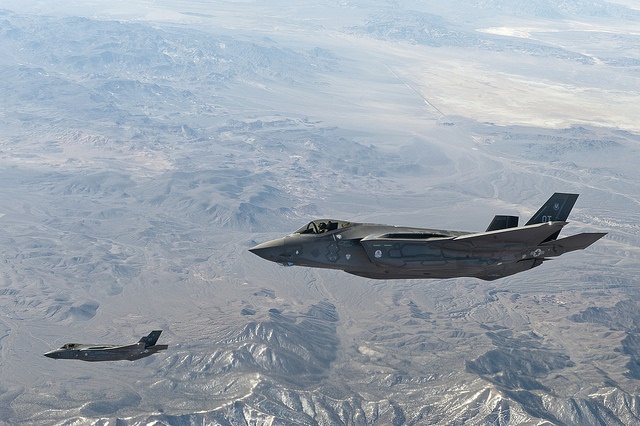The Lockheed Martin F-35 Joint Strike Fighter might be designed to “shoot and kill” its enemies at long distances, but flight trials of the A-model in January found the aircraft has trouble engaging the twin-seat F-16D Fighting Falcon at close distances.
The results of the test, published by War Is Boring, provides a stark assessment of the fifth-generation aircraft’s manoeuvrability, with the test pilot commenting that the F-35 was outmanoeuvred by the older F-16 that it will eventually replace.
The test pilot, who has experience flying the F-15E, F-16 and F/A-18F, says the F-35A’s manoeuvrability is “substantially inferior to the F-15E” because of its smaller wings, similar weight and reduced afterburner thrust.
“Even with the limited F-16 target configuration, the F-35A remained at a distinct energy disadvantage for every engagement.”

US Air Force
In response to the report, the F-35 joint programme office said the aircraft is not necessarily designed to fight in visual dogfighting situations, but at longer ranges.
“There have been numerous occasions where a four-ship of F-35s has engaged a four-ship of F-16s in simulated combat scenarios and the F-35s won each of those encounters because of its sensors, weapons and stealth technology,” JPO spokesman Joe DellaVedova said in a 1 July statement.
Maj Gen Jeffrey Harrigian, director of the US F-35 integration office, says it is too soon to “draw any final conclusions on the manoeuvrability of the aircraft”.
“Both operational and developmental test continues for the F-35,” he says. “The F-35 is designed to be comparable to current tactical fighters in terms of manoeuvrability, but the design is optimised for stealth. This will allow it to operate in threat environments where the F-16 could not survive.”
DellaVedova notes that the AF-2 test aircraft involved is used specifically for flight science testing and is not equipped with the mission systems, software, weapons, sensors or stealth coating of an operational F-35.
“The F-35's technology is designed to engage, shoot and kill its enemy from long distances, not necessarily in visual ‘dogfighting’ situations,” he says.

US Air Force
In the report, the test pilot also took exception to the lack of rearward visibility from the cockpit because of the size of the helmet. There were also difficulties looking up, making it hard to spot the nimble F-16 from above and behind.
“The helmet was too large for the space inside the canopy to adequately see behind the aircraft,” the report notes. “Whenever the helmet was pinned against the canopy, the pilot continued to strive to turn his neck, resulting in the symbology no longer being in front of his eyes.”
The report was marked “for official use only” and contains export-controlled information. DellaVedova says its release is being investigated, and the disclosure should not discourage pilots and weapons testers from providing an “honest assessments of the F-35's capabilities”.
Twelve nations have committed to buying the F-35 to replace various legacy fighters, and Lockheed Martin expects a production run of at least 3,000 aircraft.
The USAF is currently standing up its first operational F-35A squadron at Hill Air Force Base in Utah, and expects to have 12 combat jets ready in time to declare initial operational capability by August 2016. The aircraft will be delivered in the Block 3i configuration with limited air-to-air and air-to-ground attack capabilities initially.
The full suite of promised combat systems will come online in the full-up Block 3F configuration by 2017. Newer and more sophisticated weaponry like Raytheon’s small diameter bomb II and AIM-120D AMRAAM will be added in Block 4, which is due to roll out in increments between 2019 and 2025.
The Marine Corps intends to declare IOC with 10 B-model jets this month.
Source: FlightGlobal.com



















